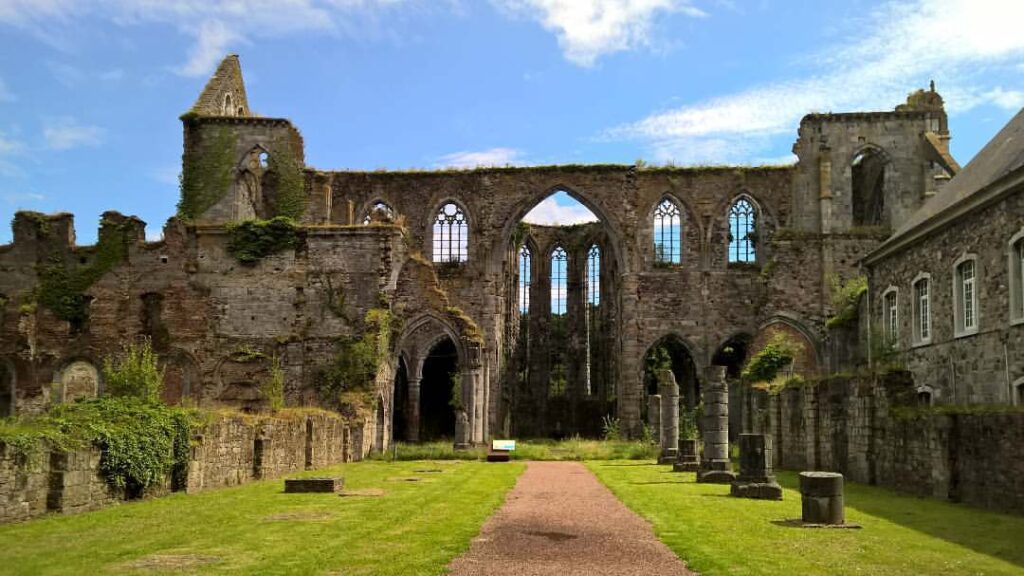Aulne Abbey, a historical landmark in the Valley of Peace
The ancient ruins of the Aulne Abbey are located in Thuin, a sub municipality of Charleroi. The ruins are located in the Valley of Peace and belonged to the Bishopric of Liège. Nowadays, it has been registered as a historic monument by the Region of Wallonia since 2006.
We recently visited the Aulne Abbey ruins to tell you all about its history and how to reach it.
Page Contents
About Aulne Abbey
The former Abbey of Aulne, located near the banks of the Sambre river, in a place known as Valley of the Peace (“Vallée de la Paix”), has its origins in the 7th century and is named after the alder tree (in French “aulne”).
According to ancient records, the Abbey was originally built in 637 by a notorious thief named Landelinus, who also founded the neighboring Lobbes Abbey. The building was later transformed into a Benedictine monastery after Landelinus’ death in 656.
The Abbey was raided in 880 by the Normans, which destroyed most of the writings. The monastery was left in ruins for half a century until bishop Richarius (922-945) finally rebuilt it.
The Benedictines were replaced from the 10th century (around 974), transforming it into an Abbey with monks who lived according to strict Christian rules. At the beginning of the 13th century, when Prince-Bishop Hugo II of Pierrepont (1202-1229) was in charge, the Abbey contributed to the spiritual and material prosperity of the region.
In its further history, the Abbaye d’Aulne went through several periods of looting, wars, and disasters. Nevertheless, the Abbey acquired several beautiful and extensive lands, making it one of the most powerful abbeys in the old Netherlands. The Abbey was also known for its enormous monastic library and housed more than 50,000 books and over 4,000 manuscripts by that time.
As indicated, the Abbey endured several wars over the years; in the 15th century, it had to do with the looting of the Burgundians, while in the 16th century, it was attacked by King Henry II of France. After the revolt of the Geuzen (also in the 16th century), the Abbey was destroyed. It lasted until the beginning of the 18th century, when Abbot Carion de Thuin paid off all debts.
Abbot Carion de Thuin and his successor Barthélémy Lovant decided to rebuild the Abbey in superfluous luxury: the Gothic abbey church was given a Baroque-style facade, it was given its own factories, a tannery, a brewery, and some enormously luxurious guest houses.
It was not until 1775 that the restoration was finally completed, but in 1794 Aulne was destroyed by the violence of Napoleon’s French Revolution, leaving only a ruin. During this revolution, the magnificent library also went up in flames, forcing the monks to retreat to a neighboring abbey.
In 1859, when the last monk finally died, certain parts of the ruins were restored and given a new purpose: a retreat house. A new Saint Joseph’s Church was also built with the material from the ruins.
In 1950, the old brewery “Brasserie de l’Abbaye d’Aulne” was brought back to life. The Brasserie still produces Belgian specialties (“Blanche de Charleroi“), respecting the brewing tradition of the Cistercian monks of the Aulne abbey.
In 2006, the Region of Wallonia finally decided to buy the Abbey and classify it as a historic landmark. The former stables of the Abbey are still used today as a brasserie (“Val de Sambre”).
Blessed Simon of Aulne Abbey
In the 12th century, Simon of Aulne lived in the Abbey, where he was assigned to work in the monastery granaries and tend the sheep. During his time at the Abbey, Simon became a mystic who experienced visions and was believed to have the gift of reading hearts.
Simon’s reputation spread like a wildfire, and was summoned in 1215 by Pope Innocent III to visit the Vatican in Rome and advise the Pope during the Fourth Lateran Council. After the Council, Simon returned to Aulne where he died at the age of eighty-four.





Essential facts about Aulne Abbey
The Abbey is nestled on the right bank of the Sambre, which is known as the “Valley of Peace.”
The Abbey is now named “Abbey of Aulne” because of its rich environment filled with alder trees. However, according to a local legend, the Abbey was named “Aulne the Rich” from the 12th century until 1794.
| Aulne Abbey Key Facts | |
| Region | Wallonia |
| Built | 637 |
| Type | Cistercian monastery // Heritage Site |
| Names | Abbaye D’Aulne, Aulne Abbey, Abdij van Aulne, Aulne la Riche |
| GPS Coordinates | 50°21’54.7″N, 4°19’58.4″E |
| Opening Hours | Open 7/7 from 10.15 a.m. to 5 p.m. |
| Entrance Fee | Cash Only: €5 / adults €4 / senior €4 / young person between 12 and 18 years oldFree: Children under 12 |
| Wheelchair Access | Yes |
| Info panels | English, Dutch & French |
| Toilets | Not available |
| Payments | Cash only |
| Parking Fee | Free parking at: Thuin—ville haute : Parking FauconnierThuin—ville basse : Rue t’serstevensThe Aulne Abbey : Rue E. Vandervelde 288, nearby the Mini-Golf. |
How to reach Aulne Abbey
While Aule Abbey is a historical landmark, it’s still a hidden gem, even for the inhabitants of Belgium. Even while the ruins are located close to Charleroi, making it pretty accessible by public transport.
| By Metro | The Aulne Abbey is located between the Landelies and Hourpes metro stations, which is a 2.5km walk. |
| By Bus | There is a bus stop in front of the Abbey: GOZEE Déversoir (Bus 192 stops here). |
| By Car | You can drive up to the parking area located near the Mini-golf; Rue E. Vandervelde 288, Thuin. |
| By train | The abbey is only a short walk from Hourpes train station. |
When to visit Aulne Abbey
The abbey is closed during the low season, which means you’ll only be able to visit it during Spring, Summer, or Autumn. The opening times may vary from the season, so the best approach would be to check their website and book a specific time slot.
What to do at Aulne Abbey
Because the abbey is surrounded by beautiful nature, there are also various activities. Such as:
- Hike. The area of the abbey is well known for its beautiful environment, hence why it’s also a popular spot for hikers. The official website highlights three specific routes:
- 6 KM walk: A walk around the historic grounds of the Abbey, where you finish the route at the local brewery.
- 7 KM walk: Promenade du Charbonnier, which visits a few historic landmarks along the way and ends at the mini-golf course.
- 14 KM walk: Sentier du Solitaire. A longer route, which allows you to walk around the Abbey and into the city, allowing you to discover Thuin’s less explored sights.
- Mountainbike. There is a specific mountain bike climb (/descent) located next to the abbey.
- Mini-golf. There is a mini-golf course located next to the ruins of the abbey.
- Music festivals. You can visit the Scène-sur-Sambre music festival during July, which even includes a festival stage floating in the Sambre river.
Other attractions near Aulne Abbey
If you are in the area for several days, it is certainly interesting to visit other tourist attractions. So there are:
- Le Beffroi de Thuin. Although historically attached to a church, the bell tower has also become a municipal tower, the only belfry of the Principality of Liège. It is one of 56 belfries of Belgium and France since 1999 classified as UNESCO’s world heritage.
- Les Jardins Suspendus. Thuin’s hanging gardens design is linked to Thuin’s Remparts. Most plants are vine plants, managed by the Biercée distillery to make a pleasant, sweet wine.
- Château de Leers-et-Fosteau. Located in Thuin, erected in the 14th century, and registered as a protected monument since 1979.
- Bois du Cazier coal mine. The Bois du Cazier is an old coal mine near Charleroi, preserved as an industrial heritage site and registered as a UNESCO World Heritage Site.
If you are looking to visit other interesting places in Wallonia, you might want to read our article about Walzin Castle or The Try-au-Chêne chapel.







